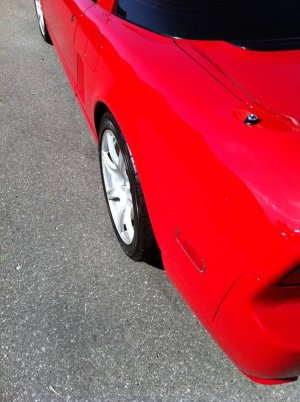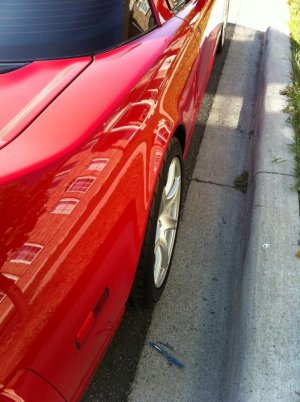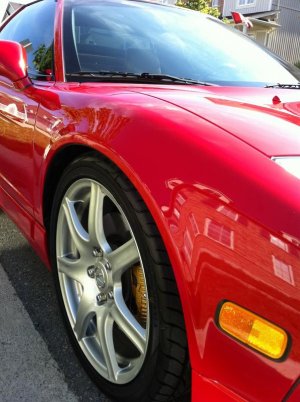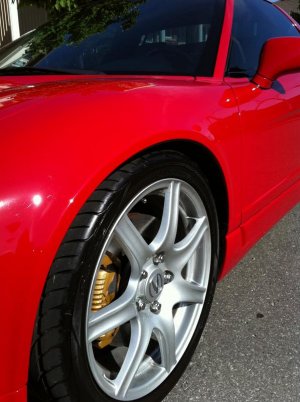Stock studs are too short to accommodate the spacer and your wheels safely.
You are using an out of date browser. It may not display this or other websites correctly.
You should upgrade or use an alternative browser.
You should upgrade or use an alternative browser.
Wheel spacers: I know this is a repeat but...
- Thread starter TURBO2GO
- Start date
Wider track = more stability and grip.
Wider rear relative to front - slightly more rear grip (added) than front (added). This is not a bad thing. 10mm wider increase in rear won't be a huge perceivable difference. Just do it so your brakes will clear.
The 'heavier' unsprung weight comment is insignificant. Wider track far outweighs a slight increase in unsprung weight.
0.02
Billy,
Can you explain how a wider track = more stability and grip?
I've been trying to find the principles behind this but I can't seem to find any. Many people say it adds more stability and grip but never go on to explain how..
From a thought standpoint, if the tires are the same size and you just push them out further, isn't there the same amount of contact patch effectively the "same" grip (assuming both the front and rear go out the same amount)?
Spacers change the scrub radius, which I have found out from here:
http://en.wikipedia.org/wiki/Scrub_radius
"A positive scrub radius will increase steering effort, torque steer and kickback on bumps to a considerable degree....The advantage is that there is much greater road feel and feedback so that when tires start to break loose in a corner it can be felt. Consequently, this is often the set-up of choice on race cars."
But these articles still don't really explain why those things occur. Care to shed some light?
I could tell right away after I installed my 25mm's all around how the car felt a bit more connected, firm and wider, I mean, I don't feel the sides of the car go to much, like, the body doesn't "roll out" - if you are very connected with your NSX you know what I mean, and I had already my RA suspension installed ...
Plus, looks better

Plus, looks better

That's a very nice looking NSX. Nice choices and details.
Tire size, Vehicle weight, etc... gives you your contact patch. With that being constant yes you will have the same size patch to work with. Now 'grip' has to do with Cg height, track width, vehicle weight, roll couple, etc... With everything constant but track width:Billy,
Can you explain how a wider track = more stability and grip?
I've been trying to find the principles behind this but I can't seem to find any. Many people say it adds more stability and grip but never go on to explain how..
From a thought standpoint, if the tires are the same size and you just push them out further, isn't there the same amount of contact patch effectively the "same" grip (assuming both the front and rear go out the same amount)?
Spacers change the scrub radius, which I have found out from here:
http://en.wikipedia.org/wiki/Scrub_radius
"A positive scrub radius will increase steering effort, torque steer and kickback on bumps to a considerable degree....The advantage is that there is much greater road feel and feedback so that when tires start to break loose in a corner it can be felt. Consequently, this is often the set-up of choice on race cars."
But these articles still don't really explain why those things occur. Care to shed some light?
Wider track = less load transfer (to outside tires) for a given lateral acceleration.
Ex:
Take a car with 50/50 weight distribution, suspension geometry, equal roll stiffness/spring rate at each end, same tires, etc.. in a steady state corner.
Now decrease the rear track. The load difference between the inside and outside rear tires is increased for the same couple. The maximum later al force capacity of a tire pair is achieved when the tires are equally loaded. So when the rear track is decreased, the lateral force capacity of the rear tire pair is decreased -resulting in oversteer/less rear grip.
Simpler:
Narrower stance = more load transfer to outside tires which 'works' the tire more and unloads the inside tire. Since the inside tire is not as loaded, it is not doing as much work so your overall grip is less. An extreme example is the inside tires are so unloaded that they come off the ground and thus don't contribute to any cornering force atall.
Wider stance = less load transfer to outside tires. This loads the inside tires more which utilizes their grip more which results in more overall grip.
The scrub radius comment is important but for all purposes insignificant for most drivers/applications. I'm not aware of any NSX with wider stance/worse scrub radius than the FXMD NSX. That car has no power steering and the scrub radius issues are shadowed by the benefit of a wider stance. Steering effort is not significantly impacted.
0.02
Last edited:
My friend (who is somewhat of a paranoid person), claims that adding spacers, or any higher offset wheel than factory will put more stress and wear on the wheel bearings and could cause them to prematurely fail. Anyone else believe in this?
My friend (who is somewhat of a paranoid person), claims that adding spacers, or any higher offset wheel than factory will put more stress and wear on the wheel bearings and could cause them to prematurely fail. Anyone else believe in this?
Absoletly. But it's not going to shorten the life of the wheel bearing by 1/2 or anything like that. My car sees alot of track time, with spacers, and still going strong on the original bearings (20k + track miles). When they start to go, they aren't that expensive.... replace them.
Street driving, I think it would be negligable.
sent from my Evo4
Last edited:
Its all relative to the car. Nissan 350Zs go through wheel bearings on heavily tracked cars very quickly and is a common thing to replace.My friend (who is somewhat of a paranoid person), claims that adding spacers, or any higher offset wheel than factory will put more stress and wear on the wheel bearings and could cause them to prematurely fail. Anyone else believe in this?
The NSXs wheel bearings are quite good. Again, look at the FXMD NSX with stock suspension geometry, wheel bearings, and 280/330 width slicks producing ~2Gs with over 1,000lbs of downforce with wider than 25mm spacers. The FXMD car has no wheelbearing issues, so you'll probably be fine.
Billy
Pics of mine with Spacers on. 25mm rears and 15mm front:
Attachments
Similar threads
- Replies
- 28
- Views
- 2K
- Replies
- 2
- Views
- 578
- Replies
- 6
- Views
- 381









